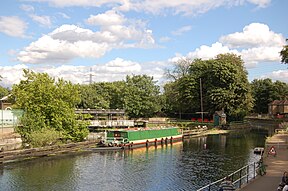Hackney Cut
| Hackney Cut | |
|---|---|

The natural flow continues over the head of the Middlesex Filter Beds Weir, Hackney Cut continues the navigation to the right. The island between contains a nature reserve in the former filter beds.
|
|
| Specifications | |
| Locks | 1 pair |
| Status | Open |
| Navigation authority | British Waterways |
| History | |
| Date of act | 1767 |
| Date of first use | 1769 |
| Geography | |
| Start point | Lea Bridge |
| End point | Old Ford |
| Connects to | (part of) Lee Navigation |
The Hackney Cut is an artificial channel of the Lee Navigation built in England in 1769 by the River Lea Trustees to straighten and improve the Navigation. It begins at the Middlesex Filter Beds Weir, below Lea Bridge, and is situated in the (modern) London Borough of Hackney. When built it contained two pound locks and a half-lock, but was rebuilt to handle larger barges in the 1850s, and now only Old Ford Lock, which is actually a duplicated pair, remains.
The River Lea (or Lee) has a long history of use for navigation, with records indicating that the Abbot of Waltham was authorised to make improvements in 1190, and evidence for tidal gates at Bow from the reign of King Edward I, when Henry de Bedyk, the prior at Halliwell Priory and owner of the nearby tide mills, erected a structure some time before 1307. River levels were managed by flash locks or sluices, and as the volumes of traffic using the river increased, there was friction between the bargees and the millers, since use of a flash lock affected the head of water available at the adjacent mill. In 1765, the commissioners responsible for the river asked the engineer John Smeaton to survey the river and make recommendations for its improvement.
Smeaton produced his report in September 1766, in which he recommended that the flash locks should be replaced by pound locks with two sets of gates, and that a number of new cuts should be built, including what became known as the Hackney Cut from Lea Bridge to Old Ford. The commissioners advertised in the London Gazette and other newspapers that they wanted to borrow £35,000 to finance the improvements, to which there was a huge response. Some £161,500 was offered, and subscribers had to be picked by a ballot. Work on the whole scheme progressed quickly, and the contract for the Hackney Cut was awarded to Jeremiah Ilsley on 18 January 1768. He was probably acting as a public works contractor, since he also had contracts for the Waltham Cut and part of the Limehouse Cut, and so must have been managing a large labour force. He was to be paid 3 old pence (3d, 1.25p) per yard for the Hackney Cut, considerably less than the rate for the Limehouse Cut, which was 7d, and was given four months in which to complete the excavations.
...
Wikipedia
